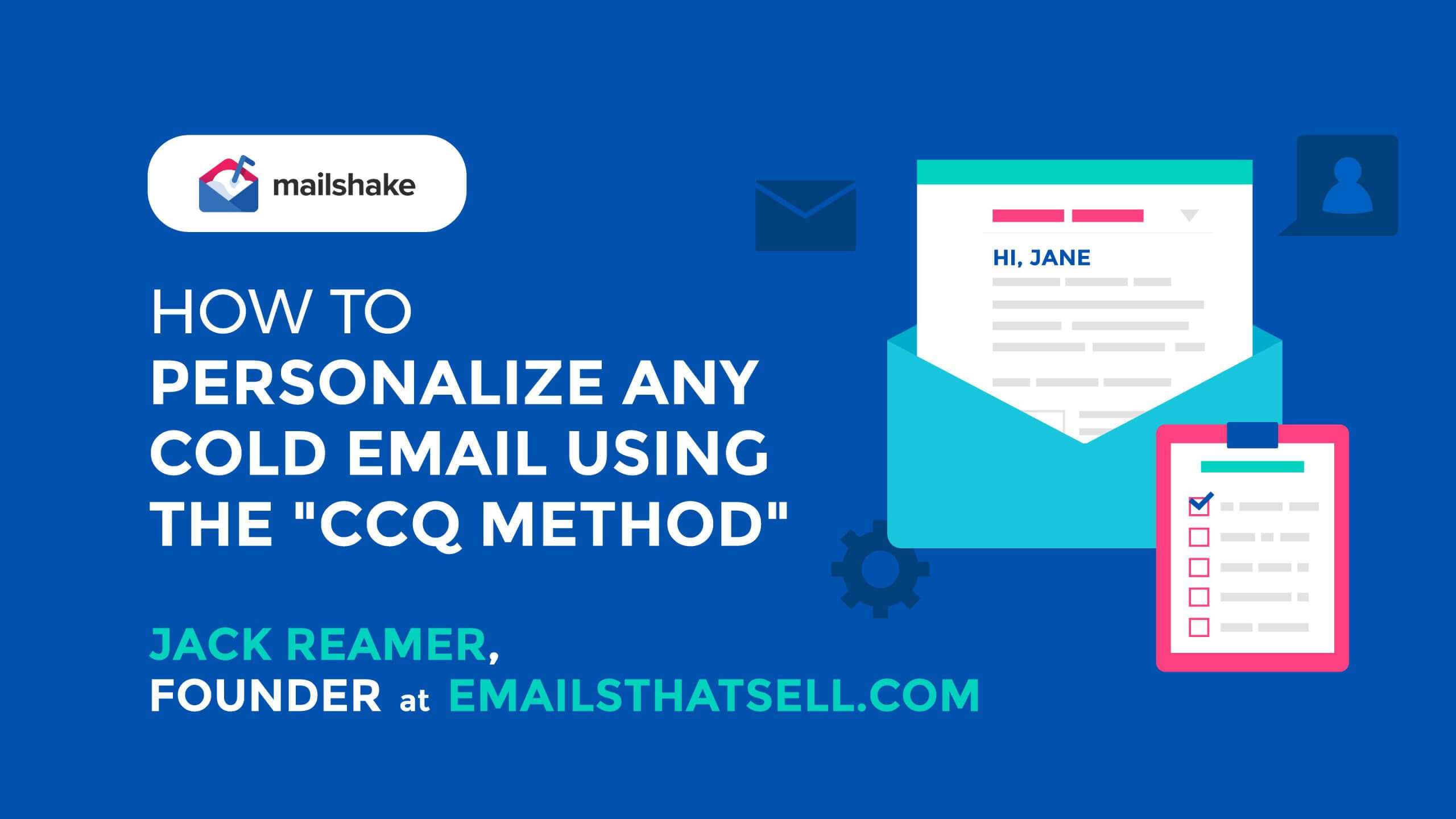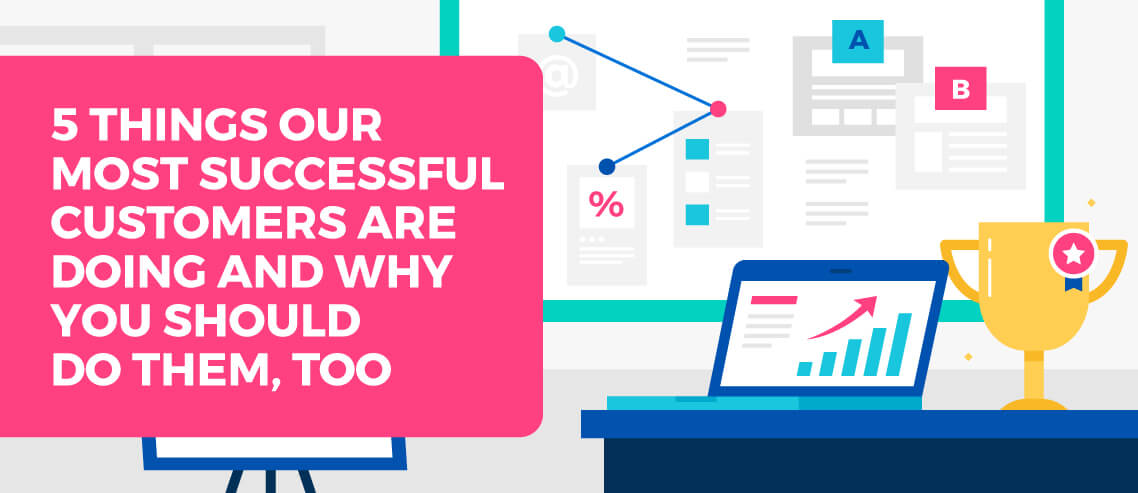Why 2020 is the Year of “De-Personalization” (And How to Get it Right)

Contents
“Oh, your open rate and click-through rate aren’t that good?” asks your irritating marketing buddy. “Well, are you personalizing your emails?”
Come to think of it, you can’t remember why you’re even friends with him.
“I started using people’s names in my emails, and I saw a 50% increase in my conversion rate!” he practically shouts. “That’s what you need. Just a healthy dose of personalization.”
He stands there proud, and you try to resist punching him in the face.
After all, you’ve tried personalizing your cold emails. You’ve added people’s names, changed the color of your CTA and even thrown “Re:” and “Fwd:” in the subject line to grab your audience’s attention.
But still, you don’t get the open-rate or click-through rate you’d like.
What gives? You’re doing all the right things, aren’t you?
At the heart of almost every marketing strategy is personalization.
Barbell Apparel sold over 9,000 jeans through personal outreach to media sites.

66% of marketers list improved business performance and customer experience as the main driver for personalization, and 94% of marketers believe that personalization is critical for success.

Personalization seems to be working for everyone else. Why not you?
Well, marketers know they need personalization, but they can’t seem to nail down exactly what personalization is.
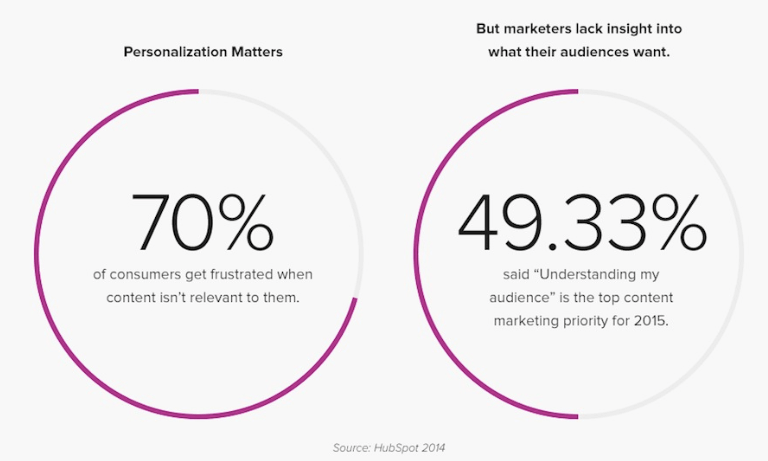
Let’s take a moment to talk about exactly what defines that fleeting word.
Personalization (and why de-personalization is better)
You receive an email that has your name in it from someone you’ve never met before. In fact, you can’t really remember how you got on their email list in the first place.
But, thus far, you’ve been too busy to unsubscribe.
How does it feel to see your name?
Do you think to yourself, Wow! They’re really talking to me! I can’t believe it!?
Probably not.
Why?
Because anyone with half a brain knows that their name in a marketing email is nothing more than merge tags.
Chances are, your friends don’t say “Hey Mike” in the email subject line.
We’re all used to marketing tactics and can sniff a seller from miles away.
This means traditional personalization — the copy on a button, including the prospects name in an email, and putting “Re:” and “Fwd:” in the subject line — is losing its traction.
But that’s not all. It’s actually harming your cold emails, too.
Think about it. When you receive an email with one of the personalization tell-tale signs, you immediately know that someone is trying to sell you something.
And that alert kills digital relationships with prospects and hurts your email list engagement.
But what’s the alternative?
Exactly what you’re thinking.
The death of personalization. Here’s why un-, im-, and de-personalizing your emails will actually give you a greater impact and how you can do it.
1. Don’t put their name in your email
Like I already briefly mentioned, including the prospect’s name in your email can kill your chance at connecting with them.
Authenticity is more valued than almost any other marketing trait. Consider influencers, for example. Why are influencers so… well, influential?
Because they are authentic and transparent personalities. And consumers trust them.
The same truth applies to your cold email efforts. People want you to be transparent with them.
Gary Vaynerchuk has built his massive following on Social Media by documenting his journey with authenticity.
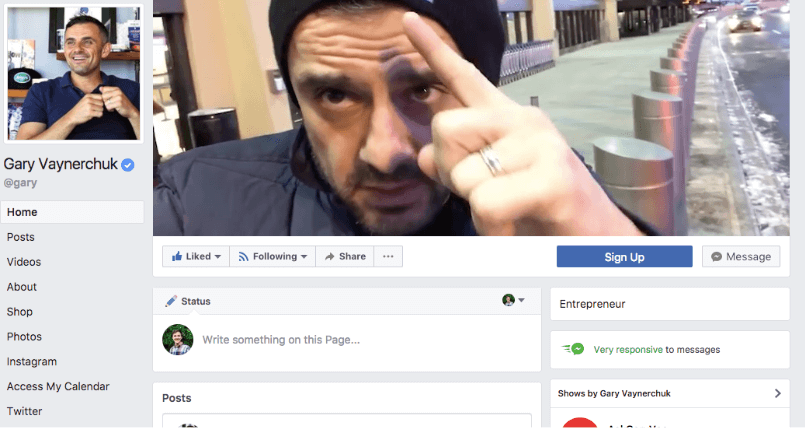
His videos aren’t always the highest-quality. They aren’t always the most put-together. But Gary’s human-ness shines through.
And people love it.
Counterintuitively, if you use your prospect’s name in their emails, it feels fake.
Why?
Because they know that you aren’t friends with them. They’ve never met you in their life and seeing their name doesn’t communicate, This message is for you, but rather, I know how to use merge tags and I have something to sell you.
And that message isn’t very compelling.
Despite his success, Grant Cardone is someone who makes this mistake in his emails.

Similarly, Ron Friedman does the same.

I never open these emails because I immediately know that they are trying to sell me something. As opposed to building a relationship or looking out for my best interests.
But what should you do instead?
Consider this amazing email subject line and excerpt from Rachel Pedersen.
![]()
It immediately expresses transparency, doesn’t seem to be trying to sell me anything and, most importantly, it doesn’t include my name.
Former 500 Startups marketer, Susan Su, calls this “de-personalization.”
Imagine the effect that this email would have on you if it arrived in your inbox.
You’d probably want to open it. It’s personal, but not in the traditional sense. It’s personal in the sense that Rachel is willing to tell me things about herself that I assume take courage to talk about.
Overall, it expresses who Rachel is, not who I am.
Which is important. Humans are completely okay with soapbox speeches so long as you have something good to say. There’s no need to pretend like you’re talking to just one person when everyone knows that you’re not.
Get on your email soapbox and own it. Think of your emails more as a public speaking gig, not a one-on-one conversation.
2. Replace the CTA with a teaser
Multiple studies clutter the internet promising that “get” will convert better than “learn” and blue will convert better than red.
But this type of personalization is completely artificial. It doesn’t actually increase conversion rates that drastically.
Sure, there’s probably something to be said for the way our brain responds to different colors and words. But, in the end, “get” isn’t going to make me buy your product if I don’t want to.
One A/B test, for example, found that the button copy on the right converted 96% better.
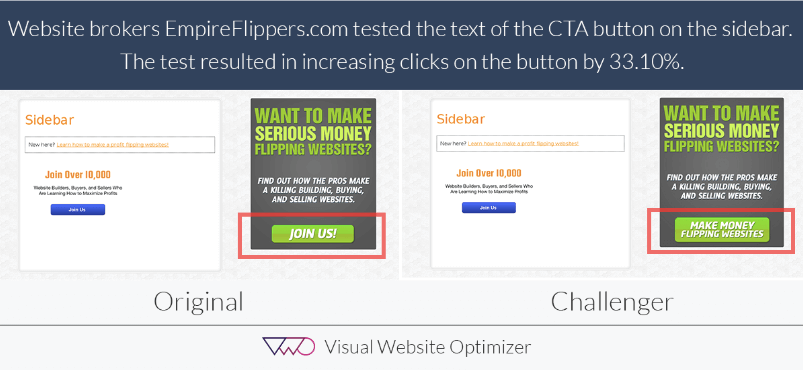
Sounds pretty convincing, right?
Except that the 96% increase was from 2.88% to 3.84%. That’s far less convincing.
Instead of playing around with your CTA copy, consider pre-selling your upcoming content, offer, or pitch with a CTA-less email.
Something like this.

Doing this will accomplish two important things.
First, it will get your audience prepped and ready for whatever you’re going to offer soon.
Second, it’s an email without a CTA, which improves trust with your audience — they won’t think you’re always just trying to sell them something.
And that’s a prospect relationship worth building.
3. Provide value without asking for anything
Practically every marketer preaches that you shouldn’t create a piece of content, send out an email, or talk to a prospect without some sort of pitch.
“You have to give them something else to do,” they say. “Otherwise they’ll just forget about you and move on.”
Let me speak for all prospects when I say this: I’m okay with not always being pitched something. I won’t forget about you, and I’ll probably just trust you more because you aren’t always in it for yourself.
Inbound marketing lives and breaths on creating free value for clients, customers, and prospects.
Why does inbound marketing work?
It’s no secret that people appreciate when you go out of your way to help them. But they don’t just appreciate it. They’ll trust you more and probably buy from you in the future.
People buy from people that they like. Period.
And providing free value is a great way to get people to like you.
Michael Hyatt, author of Platform and guru of all things audience-building says this:
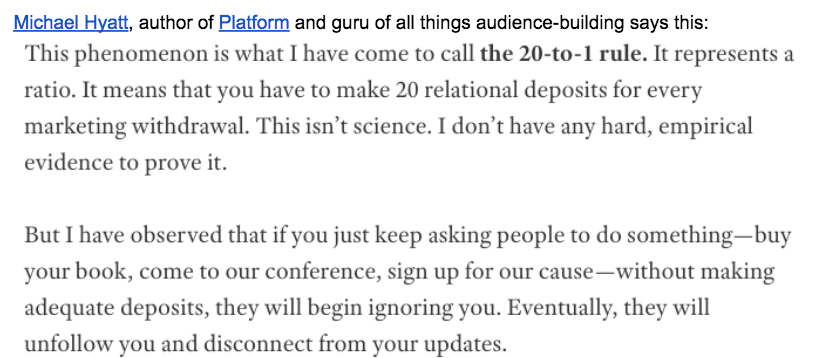
In short, give way more than you take. People are more likely to buy from you if they no you’ve already given them loads of value.
If you want to systematize the process, you can follow Michael Hyatt’s rule of 20-1. Provide 20 pieces of free value before asking for anything in return.
As marketers, we want to make sales and build our clientele and grow our business. But we can’t forget that those things only happen once we provide enough value to people that they believe they can trust us when making a purchase.
It’s on us to take the initiative in building that trust. It isn’t the prospect’s job.
Rachel Pedersen is someone who realizes this with her emails. Her emails always provide free value and have absolutely no CTA at the bottom.
In other words, they build relationships.
This is where, in one of her emails, she provides free value and advice to her list of prospects.
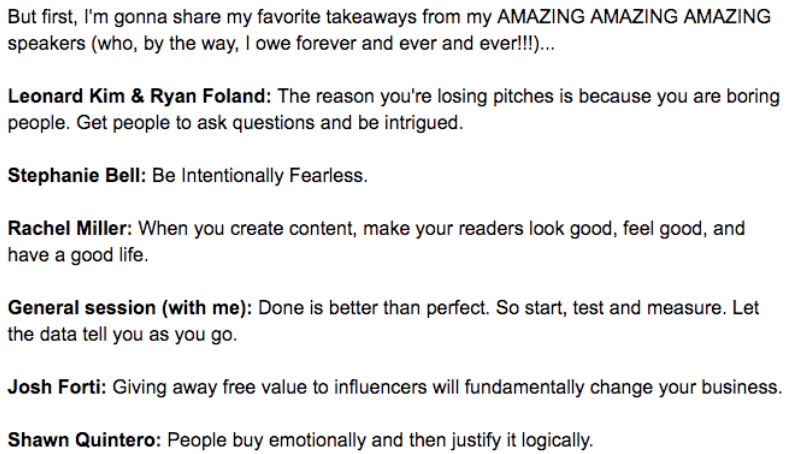
And this is how she ends her email — notice there is absolutely no pitch, just a friendly farewell.
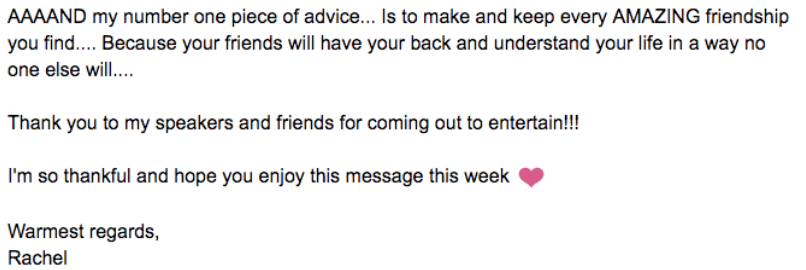
What’s the benefit to doing this?
Every time that Rachel pitches me a course she’s offering or a product she created, I buy it. Simply because I trust her.
And trust is worth a thousand sales.
4. Hone your writing voice
While traditional methods of personalization are dying out, a new wave is rising.
Namely, personalization through a strong and consistent writing tone.
Again, people are okay with you standing on your pedestal and speaking. Your job is to get that audience to like you and enjoy reading your emails.
To do that, you need to add some personality to your writing.
Don’t just write old, boring, cliché emails, include a style that makes it uniquely you.
The Hustle, a daily email newsletter has a consistent, hilarious, and personable voice across all of the emails they send.
Because of this, they are growing absurdly fast.
Here’s a section from one of their emails.
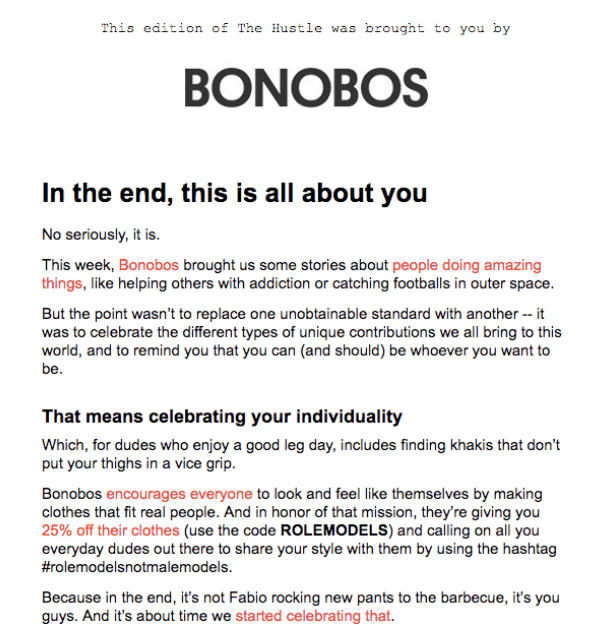
As you can tell, the tone is irreverent, lighthearted, and witty. For The Hustle’s audience, this works.
You might be afraid of creating email copy like this. Will it scare off your audience? What if they’re already used to what you’ve been doing?
Remember, you don’t have to copy this irreverent tone. Make your own voice that’s appropriate for your audience and will appeal to the correct group of people.
Ultimately, be yourself and your audience will appreciate it.
And then, make sure that your voice is consistent throughout all of your emails. Here is another email from The Hustle that illustrates the consistent tone with which they write.
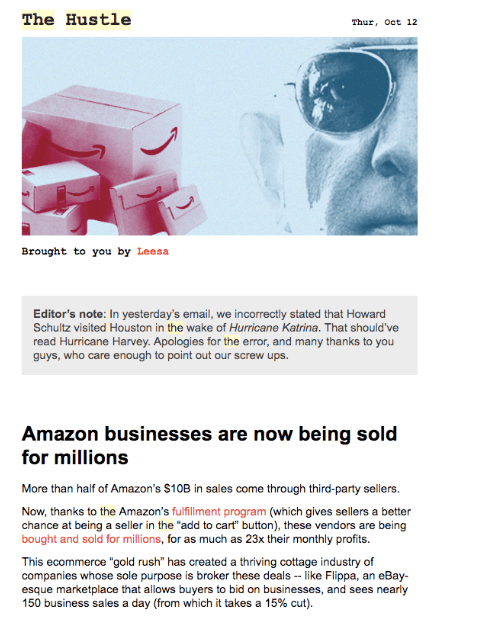
If you write with a certain tone in one email and then a new tone in a different email, people might get suspicious that you’re not writing your emails — and that’s no-brainer for a prospect relationship that requires trust.
Choose your tone, define it on paper, and then consistently write emails that have the same voice.
Even when The Hustle does their sponsorship portion at the end of each newsletter, they keep it personable. They don’t become ‘salesy’, and they don’t pretend that someone else is doing the pitch.
They keep it fun and make it themselves.
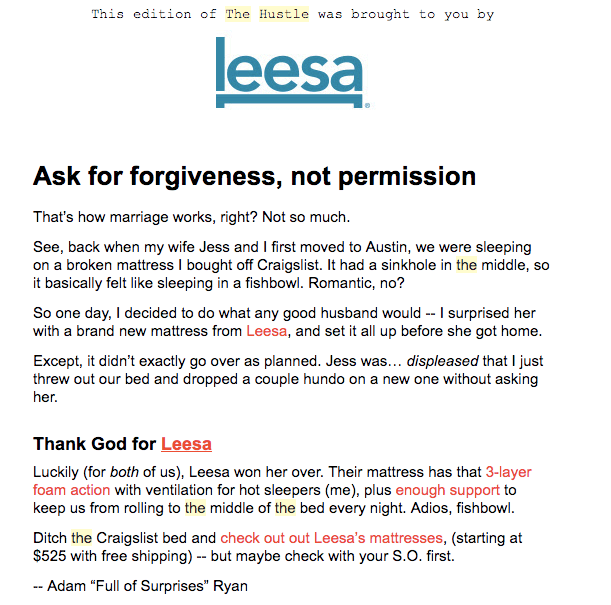
Here’s another email pitch from The Hustle.
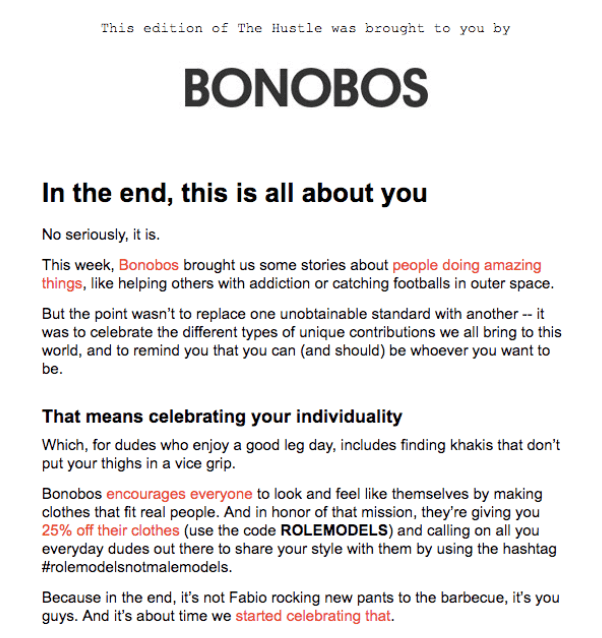
The worst thing you can do is write an email that resonates with your audience and ends it with a heavy-handed pitch.
People will immediately lose that trust you took so long to build.
Whether you’re providing value, pitching a product, or discussing an experience, be yourself.
Nothing builds trust quite like a writing tone that humanizes you.
Conclusion
Prospects want to work with you. They want to become your friend, build a relationship, and purchase your service.
You just have to let them.
No prospect wants to feel like they’re living in your marketing sheep-pen, just a number, and no more value to you than the money in their pockets.
Since traditional personalization is now recognized as marketing-speak, everyone sees it for what it is. Namely, a bunch of impersonal bullshit.
And the last thing you want is for your prospects to think you just want them for their money.
To build trust with your prospects, don’t include their name in an email, use teasers occasionally instead of CTA’s, provide value for free before asking for anything in return, and hone your writing voice.
True personalization isn’t saying someone’s name or changing the color of a button, it’s communicating through authenticity and transparency that you care about the people on your list.
So much that you’re not going to market to them. You’re going to build a relationship with them.
Because, you know, relationships sell.



